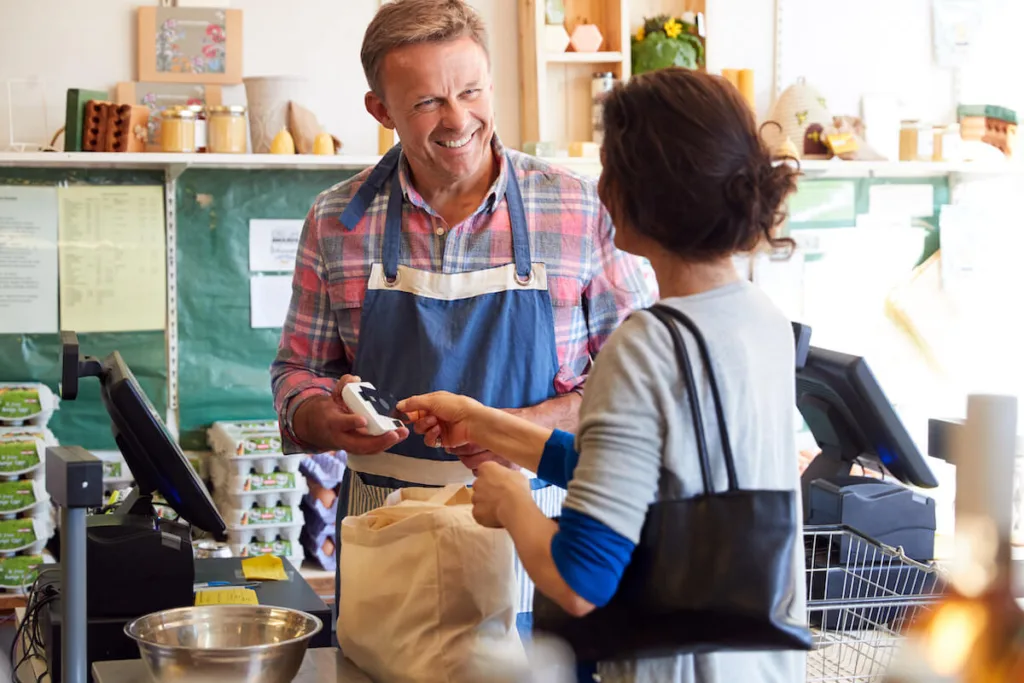How to promote your business locally: 10 simple tactics

Key takeaways
- Competition for local customers is fierce, so it’s essential to relate to consumers and stand out from your competitors
- Winning local customers requires a combination of digital marketing and in-person tactics
- Some local marketing strategies come at a cost, but many are free and relatively easy
As a small business owner, you want to relate with local consumers, be part of the community, and stand out from your competitors. But knowing how to promote your business locally requires some smart marketing tactics. Because there are a finite number of customers in your area, local marketing initiatives are a top priority—not to mention your competitors are vying for the same customers you are.
To set yourself apart from the competition and find ways to capture the attention of local customers, check out these 10 different marketing strategies.
How to promote your business locally

There isn’t one definitive marketing effort that will win over local customers. Connecting with potential customers requires a combination of digital marketing tactics and in-person marketing initiatives.
1. Grow your email list
Email marketing isn’t a new idea, but it’s still a powerful way to help convert leads into customers, drive brand awareness, and increase customer acquisition and retention. In fact, 87% of companies report that email marketing is critical to the success of their businesses.
Email marketing is even more effective when you segment your email list by demographics such as age, location, or interests. But how can you entice people to willingly give you their contact information and sign up for your email list?
One way is to have sign-up forms and calls to action on your website, blog content, or onsite at your business. You can also incentivize customers in your store with discounts on their next purchase if they sign up.
2. Add your business to local online platforms
You can submit your business profile and contact details to industry-specific local listings—usually run by professional organizations—or to your local Chamber of Commerce. Review sites and local business platforms like Yelp put your business on the radar of local consumers and let potential customers research your company before deciding to make a purchase.
For instance, your Yelp Business Page is a one-stop-shop where you can upload photos of your business, write a business description, add your address and phone number, respond to online reviews, and more. Adding or claiming your Yelp Business Page is free and only takes a few moments.
3. Master social media marketing
Social media marketing channels like Facebook and LinkedIn are popular ways to interact with customers and other local business owners.
Consumers often use social media platforms to research local businesses and interact with them. As such, you should be active on your channels and ready to respond to any comments or questions they have.
You can use your Facebook page to promote sales events, seasonal offers, or contests. Part of knowing how to promote your business locally means keeping your posts relevant to your local market—tap into what makes your community unique and use messaging that is relatable to your local audience.
LinkedIn is a platform you can use to network with other small business owners and entrepreneurs. Doing so can open doors to potential partnerships, collaborations, or events with other local businesses.
4. Set up a direct mail campaign
When you’re considering how to promote your business locally, don’t rule out traditional marketing strategies. Direct mail campaigns have been around for a while but they’re still highly effective, especially if your target market includes people who don’t often use email or social media. In fact, 74% of marketers say that direct mail delivers the best ROI of any channel used.
Frequent internet users see numerous ads a day. Sending a physical brochure could help you stand out from the crowd. When designing your brochures, include your business name and contact details, plus a coupon or discount voucher. Also, issue a call to action to tell prospective customers what steps to take next. For example, perhaps they need to present the brochure at your business by a certain date to receive the discount.
You can also invest in local advertising by posting an ad in the local newspaper in the classified ads section, depending on your target market.
5. Start a referral program
A referral program can bring you high-quality leads while strengthening your relationship with current customers. Because 88% of consumers said that they trusted recommendations from people they know—above all other forms of marketing messagings—this type of marketing strategy is an excellent way to build awareness organically through word of mouth.
Offer your current customers an incentive to refer their friends and family. For example, a lawn care provider could start a referral program that gives customers a free shrub trimming or lawn mow for every customer they refer. The new customers who were referred could also get a free mow after their first purchase.
6. Use locally targeted ads
Including local digital ads in your marketing campaign gives you access to an audience you might not otherwise reach. The power of online ads lies in the ability to target specific local audiences.
Your first option is search engine marketing (SEM). These are the advertisements that appear above local search engine results. You can choose a target audience and specific terms for your ads so your business shows up above the organic search results when locals search for your goods or services.
Let’s say you run a salon in Detroit, Michigan. You might want to pay for ads that show up every time someone searches “best salon in Detroit.” This way, your business is one of the first things a user will see on the page.
You can also consider pay-per-click (PPC) ads on popular platforms like Yelp. For example, Yelp Ads work to promote your business in key places on Yelp.com and the Yelp mobile app, such as above or below relevant search results in the “Sponsored Results” sections and on your competitors’ pages. You’re in control of your budget and can pause your ads at any time. Additionally, you’ll only pay when someone clicks on your ad, ensuring your investment is going toward customers who are more likely to spend.
7. Get involved in the community
Looking for an organic way to promote your business locally? Showing that you’re a contributing member of your local community and genuinely care can go a long way with prospective customers. Look for opportunities like fundraisers, volunteering, or local events that your business can participate in to give back to the community while subtly spreading brand awareness.
You could even partner with a local charity and hold a fundraising event at your business. You can donate proceeds to a good cause while also getting foot traffic in your door.
8. Promote a loyalty program
Loyalty programs can help you secure repeat business and build customer loyalty. Existing customers will be more inclined to frequent your business if they know they’re receiving a perk with every purchase (or after a certain number of purchases).
Consider offering members a discount on purchases or incentivize them with complimentary products or free upgrades.
For instance, if you own a cafe, you could provide loyalty cards and give members a stamp for every coffee they purchase. Once they hit a certain number of stamps, they can receive a free coffee of their choice. Or if they spend a specified amount of money at your shop, they could receive a free gift with purchase.
9. Write a blog
Blogging is a free and effective marketing tool to drive traffic to your site. It can bring in visitors from all over the world, and more importantly, you can use it to promote your business locally, whether you’re selling products via e-commerce or in-store only.
Effective blogging is more than just writing about topics you think people are searching for. You must have a search engine optimization (SEO) strategy supported by a thoroughly researched keyword strategy to see measurable results from your blog.
For example, a law firm in Austin, Texas, might wonder how it can get more clients who have had workplace injuries. By researching locally searched terms, it determines that many people in Austin have questions about “work injury laws in Austin.” This becomes a blog topic and, with SEO optimization, helps the business’s website see an uptick in local SEO performance.
Use free keyword research tools to plan out your strategy and choose the most relevant and popular search terms in your area. Knowing what your audience is searching for is the first step in creating content that will drive traffic and results.
10. Partner with local influencers
A social media influencer is someone who has an engaged following online and can influence other consumers’ purchasing decisions. Consider partnering with local micro-influencers, who usually have a following of 1,000 to 10,000 people. They can be relatively inexpensive since their reach isn’t as wide, but they’ll likely have high engagement rates within your community, making them impactful and cost-effective. You can either pay them a fee or offer free products in exchange for posting about your business on their social channels.
Because these social media influencers have spent time building trust within their following, their recommendation to visit your website or purchase your goods or services can carry a significant amount of weight. Think of it as a recommendation from a friend and building word of mouth.
Use the power of a local marketing strategy
If you’ve been thinking about how to promote your business locally, implement some of the promotion strategies in this guide. Many of the ideas are easy to execute and won’t cost a fortune.
Start with the simple suggestions first, like volunteering in your community, starting a referral program, and claiming your business page on Yelp. You can then move on to the more labor-intensive ideas, like writing a blog, partnering with influencers, or running digital ads. Soon you’ll be expanding your reach within your community and growing your customer base. For more, check out these 11 creative ways to get your business noticed.
The information above is provided for educational and informational purposes only. It is not intended to be a substitute for professional advice and may not be suitable for your circumstances. Unless stated otherwise, references to third-party links, services, or products do not constitute endorsement by Yelp.




